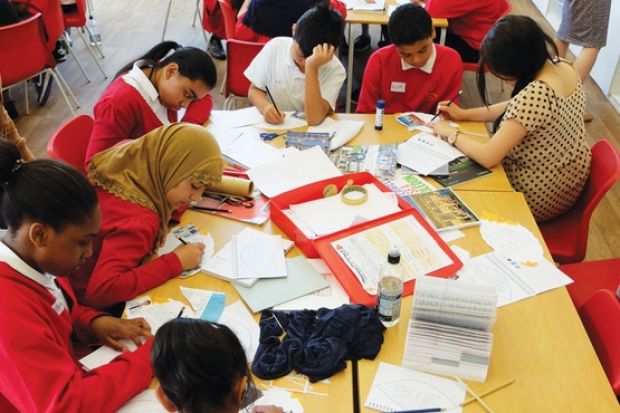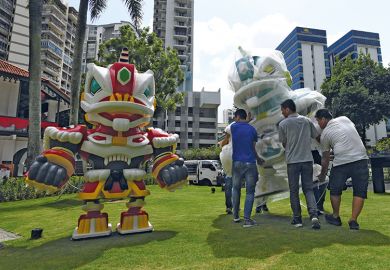“When I am older I want to invent something revolutionary that will change the world,” explains 11-year-old Malik Al-Morhiby.
Standing in front of his classmates at Daubeney Primary School in Hackney, he is no less confident about his intended degree course: “electrical engineering at Harvard University”.
Other pupils step forward to talk about their aspirations. They are not so set as Malik on achieving global fame and fortune, but their desire to study at university is equally strong.
Several want to do medicine, some criminology, others mechanical engineering. One kung-fu-obsessed pupil explains how a sports science course at a Hong Kong university is his dream.
Melisa Curri, a confident 10-year-old, informs her peers that she wants to study journalism at City University London so that she can eventually read the news on the BBC.
The presentations by the Year 6 pupils follow a morning of research into higher education organised by the educational charity Into-University as part of a week of activities at its centre in Hackney. The charity’s funders include major financial corporations such as UBS, J. P. Morgan and Deutsche Bank.
With both private and institutional funding set to rise, IntoUniversity (which is Times Higher Education’s nominated charity for its THE Leadership and Management Awards this year) is aiming to open its 20th centre by 2017.
In Hackney, children have been busy working together in small groups in the converted church hall: cutting out pictures from university prospectuses; reading about courses, clubs and societies; and talking to teachers and IntoUniversity staff about what their favourite subjects might allow them to study at university.
Pupils will later visit Queen Mary, University of London for a tour, where they will be awarded certificates for their team’s project on a mathematics-related subject they could study at university, such as engineering, astronomy, economics or architecture.
The week’s activities are the start of a process of familiarising pupils from some of the country’s poorest neighbourhoods with higher education, explains Hugh Rayment-Pickard, IntoUniversity’s co-founder and director of development.
He hopes these children will return regularly over the next six years for after-school homework clubs, one-to-one mentoring from undergraduates, classes on choosing GCSE subjects, or support in picking degree courses and writing personal statements. But he believes the initial contact in the early years is most important.
“At this age, children have not created any negative conceptions of themselves,” Rayment-Pickard says. “We’ve had great success by working with them so early on because they are incredibly receptive to new ideas. They haven’t been exposed to the negative culture that you find in some secondary schools.”
Ahead of the curve
Interacting with children at a young age with a structured support programme lasting several years is now widely accepted as one of the most effective ways of improving university participation rates in deprived areas. Indeed, several examples of early years engagement were highlighted by Les Ebdon, director of fair access, in his first guidance letter to institutions, published in January, on how they should undertake school outreach.
But the approach was largely untested when IntoUniversity launched in 2002, setting up its first centre in North Kensington – one of London’s most deprived areas despite its proximity to the mansions, Range Rovers and Rolexes found in the affluent southern part of the borough.
“While the schools were very good, young people were not talking about post-16 education or what university study could do for them,” says Rayment-Pickard. “These conversations weren’t happening.”
The charity’s work in North Kensington, where nearly half of children receive free school meals and 40 per cent have English as a second language, appears to be paying off.
Of the 2004-05 Year 6 cohort supported, 56 per cent have won a university place and 20 per cent are in the process of applying. To put that in perspective, 18 per cent of pupils on free school meals make it to university nationwide.

The charity’s success is underpinned by “demystifying” higher education for children whose parents lack first-hand experience of it, says Alexandra Tyson-Beer, team leader at the Hackney centre.
“Some children have no know-ledge of university and no idea of what they need to do to get there. We want to give them information about higher education, but we also do projects similar to study at university. Children work on just one topic, building their research skills and confidence.”
Greater reach for outreach
With the help of university staff and students, as well as financial support from businesses and philanthropic organisations, the charity – not to be confused with INTO University Partnerships, the UK education firm offering pre-degree courses to international students – now has 12 centres providing support for almost 12,000 pupils a year.
Nine are in London’s toughest areas – the Hackney base is just a stone’s throw from the so-called “Murder Mile”, otherwise known as Lower Clapton Road – but there are also two in Nottingham (St Ann’s and Broxtowe) and one in Bristol’s St Pauls district. Mirroring the close links with various London universities enjoyed by the centres in the capital, the trio calls upon the support of staff and students at the University of Nottingham or the University of Bristol to provide mentors for disadvantaged pupils.
The mix of full-time staff and university volunteers has proved an attractive proposition for corporate donors as well as charitable trusts, whose contributions make up more than half of IntoUniversity’s £1.8 million turnover.
Solid and identifiable results also help, adds Rayment-Pickard.
IntoUniversity chooses the schools it works with, after which each will pick a group of pupils with whom the charity will work.
Seventy-seven per cent of IntoUniversity’s school leavers win university places – almost double the national progress rate for state school pupils.
Almost a third attend what IntoUniversity terms “high-status” institutions – those in the top half of The Times Good University Guide. And 12 per cent leave for Russell Group members, compared with the 2 per cent on free school meals nationwide who make it to such institutions.
“Our funders put us under pressure to demonstrate our impact,” says Rayment-Pickard. “Firms such as UBS, J. P. Morgan and Deutsche Bank are driven by numbers, so want to know exactly what we are achieving.”
Recently, investment bank BlackRock donated £500,000, although the organisation hopes to attract more support from universities themselves, whose outreach spending is set to almost double to £110.7 million by 2016-17 as extra tuition fee money comes on tap.
Back in the classroom, children are invited to pick out positive things they liked about each other’s presentations. Many cite the help given to students having trouble pronouncing difficult words as a good example of teamwork; others compliment their friends on their ideas for the future.
Smiling broadly, Daubeney Primary’s Year 6 teacher, Jeeva Naidoo, is impressed by how the students support the less confident or less talented speakers.
“They are learning to work together – that’s very important in a mixed-ability class,” he says.
“It is good that they’re exploring how they can use maths and what they might do in university, but what I like is the way they collaborate. It is moulding them into lovely, caring citizens.”




